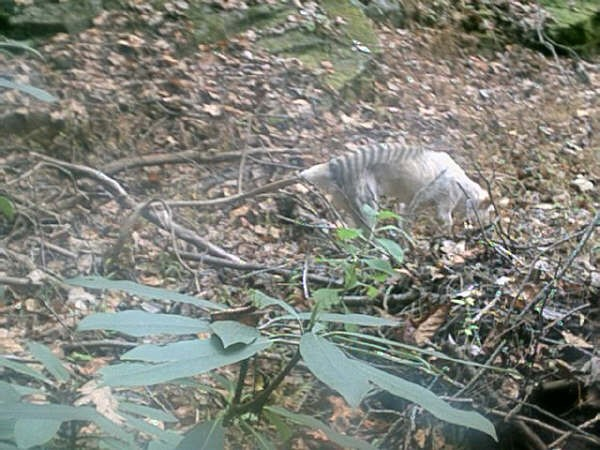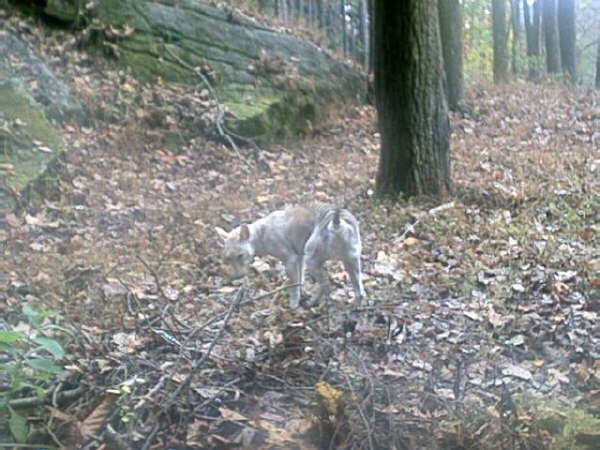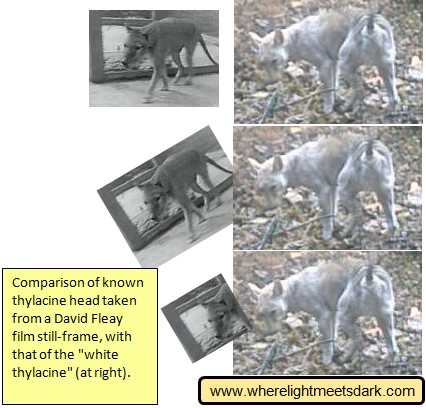White thylacine
Summary
In 2005 I located these two photographs via a discussion group related to the Tasmanian tiger.
The group was formed in April 1999 and one of the earliest contributors was Australia's late Peter Chapple, known for his part in establishing the Australian Rare Fauna Research Association (ARFRA).
Over the first 5 years very few messages were posted to the group. One quoted an article that referred to the Tasmanian government's position on responsibly establishing the existence of the thylacine.
On 1 November 2004 a message was posted which simply contained 3 links. The poster's username was displayed as: "thylasign@..." - hence, the account name appeared to be an email address beginning "thylasign".
I secured my copies of these images on 22 March 2005. I recall that either 1 of the links was dysfunctional, or possibly all 3 were; in any case it took me some time to track down the images. I believe I attempted to track down the contributor as well, but without luck.
The images
Initial response
At the time, several features stood out: firstly, the animal appeared far paler in colour than I might have expected, given the colour of skins available for viewing in museums. Hence, on this website I have referred to this as the "White Thylacine" ("white" referring to the colour).
Despite this, the striping seemed reasonably accurate.
There was also something about the face of the animal - in particular the eye region - which seemed to resemble a thylacine.
On the other hand, there were also a few features which seemed to suggest this might be a hoax.
Firstly the animal's ears appeared far longer than might be expected for a thylacine. Nevertheless, some known historical photographs of thylacines seem to show ears longer than expected for the species.
Finally, the animal's tail appeared most peculiar. The tail length and lack of fur appeared genuine enough but the butt of the tail appeared almost as if a bushy-tailed dog had been shaven. Further, the stripes did not extend onto the butt of the tail.
The depth of the animal's chest matches that of the animal in one of David Fleay's films, but the length of its neck appears shorter.
On all accounts these photos appear to show a reasonably well executed hoax in which a dog was painted, shaved and photographed.
Familiarity with humans
It is important to note that the photos appear to have been taken by a person. That is, if these were taken by a wildlife camera, then we should expect the background environment to be in essentially the same position in each photo; but there is enormous variation.
Assuming then that the photographs were taken by a human, this animal was clearly not disturbed by the presence of the human. This runs completely against what is known of thylacines in the wild, but of course would be consistent with a pet dog.
Expert opinion 1
I sought the opinion of a well-known amateur researcher who had far more experience than I with investigating thylacine claims. I will keep them anonymous as our conversation was confidential. However, the essence of their opinion was that:
- the photos are North American fakes
- they existed for several years before I made my enquiry
- they are computer enhanced photographs of specimens at the American Museum of Natural History
- the foliage in the photograph is not Australian
I expressed that I felt the photos were of a live animal but was reassured that a museum specimen had been used.
Expert opinion 2
I next sought the opinion of my colleague Michael Nelson, who has joined me on the 2009 - 2010 Tasmanian Tiger Expedition.
Michael is a vet and was also of the opinion that these photographs showed a dog.
Recent publication
A regular reader brought to my attention that smaller versions of these images were published on the cryptozoology forum (http://www.cryptozoology.com/forum/topic_view_thread.php?tid=22&pid=729131) on 5 January 2010.
I now present these high-resolution versions for debate.
Foliage
In response to my colleague's opinion that the photos were taken in North American habitat, I will seek the opinion of an Australian flora expert and report back here shortly.
Conclusion
I believe this is a painted, shaved dog. An expert with significantly more experience than me assures me that these are computer manipulations of photographs of museum specimens. There is an open question as to the species of plants in the photograph, which I will continue to investigate.


